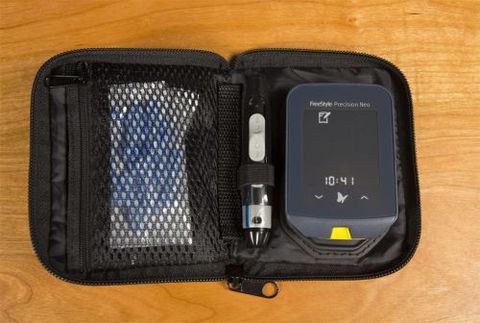In previous years, I’ve reviewed the FreeStyle Lite, which was the smallest glucometer on the market. This year, I reviewed the new FreeStyle Precision Neo, which is one of the biggest meters available. It's quite the contrast. That said, the Precision Neo is the better of the two because it has a large, high-contrast display that's easy to navigate and read. In addition, the test strips come individually wrapped, which may seem small but makes a surprisingly big difference in how easy they are to use.
I tested the relative accuracy of the 11 best glucometers multiple times a day over the course of three weeks, and the Precision Neo came out with a B grade. During each testing session, I used all the glucometers to test the same sample of my blood. I then calculated an acceptable accuracy range, with the minimum set at 15 percent below the average and the maximum at 15 percent above it. For example, if the average for one round of tests was 107 mg/dL, then the acceptable range would be 91 to 123 mg/dL.
My results aren’t an absolute indication of accuracy. In fact, to be sold in the U.S., the FDA requires all glucometers be within 15 percent of true glucose 95 percent of the time, and each one goes through rigorous testing to prove it is capable. Since finding true glucose levels requires tests done in a medical lab, it wasn’t feasible for me to use the FDA’s standard. However, it's reasonable to assume that true glucose would be closer to the average than not, so readings that fall outside the range I set are more likely to be inaccurate than those that fall inside it. That said, with such a small-scale test, my accuracy grades should be viewed as anecdotal.
The Precision Neo’s test strips received a B in my price evaluation because they only cost about 46 cents each, which makes them more affordable than those used by big-brand glucometers. For example, the Accu-Chek Aviva and OneTouch Verio both use strips that cost more than $1 each.
However, the Precision Neo’s test strips weren't available in most of the online diabetic supply stores I visited, which is concerning. I did find them in national-brand pharmacies like Walgreens, Walmart and CVS, though.
The Neo’s test strips are different from others in that they don't come in a vial. Instead, they are individually wrapped in easy-to-tear foil. After three weeks of testing glucometers two to five times a day, I found that test strips are not always easy to get out of a vial, especially not one at a time. Vials cause strips to clump together, so I often pulled out three or four. Every time a test strip exits its vial, it’s introduced to potential contaminates that make it less likely to produce an accurate reading. It was easy to pull the Neo’s wrapped test strips out one at a time, and even if I pulled out more, I knew they weren’t contaminated. Of course, the downside is the waste – so many wrappers to throw away.
Most test strips drink up between 0.3 and 0.5 microliters of blood, but the Precision Neo’s strips require 0.6 microliters. That single microliter may not seem like a lot until you compare it the samples required by other strips. Because the Neo’s strips are so thirsty, they are more prone to failing than a lot of the others. In the course of my tests, two strips produced error readings and two refused to drink the blood. Still, this is a low failure rate compared to the number of tests I performed, so it's only a minor concern.
The Precision Neo’s display is one of the best I've reviewed in years – it’s the biggest, and it features a high-contrast display that doesn’t show glare in sunlight. This makes it easy to read even if you have vision problems stemming from your diabetes. In addition, the glucometer’s controls are very intuitive, which makes it easy to access all the features on the display.
One of the FreeStyle Precision Neo’s biggest drawbacks is it doesn’t have Bluetooth or sync with an app on your smartphone. Rather, you have to upload your readings to your desktop computer and use data management software.
The FreeStyle Precision Neo is a good glucometer, but it's not the best. The test strips aren't expensive, and they are available in most big-brand pharmacies. However, they require more blood than other strips. In addition, the Neo’s lack of Bluetooth puts it behind simply because it doesn’t make managing your data as easy as other glucometers do.



